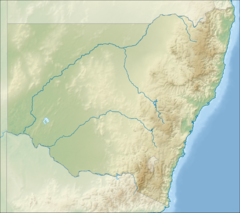Mongoose National Park
| Mungo National Park | ||
|---|---|---|
| Walls of China | ||
|
|
||
| Location: | New South Wales , Australia | |
| Specialty: | Lakes, paleontological finds | |
| Next city: | Mildura - Balranald | |
| Surface: | 278.47 km² | |
| Founding: | 1979 | |
| Lake Mungo | ||
The Mungo National Park (English Mungo National Park ) is a national park in the southwest of the Australian state of New South Wales .
It is located 743 km west of Sydney in the Balranald area . It belongs to the Willandra Lake Region ( World Heritage Site ), which covers an area of 2400 km² and contains 17 dry lakes. The second largest dry lake and the main component of Mungo National Park is Lake Mungo .
The national park is of paleontological interest as several exceptional archaeological finds have been found in the area. The first thing that was discovered was the skeleton of the Mungo Lady , which was originally estimated to be 26,000 years old. When the skeleton of the so-called Mungo Man was found, its age was scientifically examined and set at about 40,000, whereupon the age of the Mungo woman had to be corrected to about 40,000 years. The Mungo Lady and Mungo Man are both ritually buried and are the oldest known human remains in Australia. Both remarkable finds are testimony to the millennia-old history of human and Aboriginal development .
Furthermore, around 20,000 year old footprints of early humans were found on the banks of one of the dried up lakes in the clay soil.
At Lake Mungo, a bizarre semicircle of dunes, called the Walls of China , has formed at the edge of the lake . The vegetation of Mungo National Park consists of salt bushes on the slightly salty soil of Lake Mungo and the plants typical of New South Wales. The fauna consists of kangaroos , lizards , pine cones lizards , bearded dragons , Taipanen and echidnas as well as parakeets , finches , doves and eagles .


